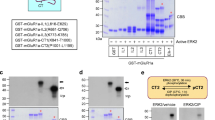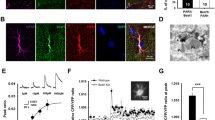Abstract
NMDA receptors (NMDARs) are involved in synaptic transmission and synaptic plasticity in different brain regions, and they modulate glutamate release at different presynaptic sites. Here, we studied whether non-postsynaptic NMDARs, putatively presynaptic (preNMDARs), are tonically active at hippocampal CA3–CA1 synapses, and if they modulate glutamate release. We found that when postsynaptic NMDARs are blocked by MK801, D-AP5 depresses evoked and spontaneous excitatory synaptic transmission, indicating that preNMDARs are tonically active at CA3–CA1 synapses, facilitating glutamate release. The subunit composition of these NMDARs was determined by studying evoked and spontaneous excitatory synaptic transmission in the presence of Zn2+, Ro 25-6981, and PPDA, antagonists of NMDARs containing GluN2A, GluN2B, and GluN2C/D, respectively. We found that evoked and spontaneous release decreased when the activity of NMDARs containing GluN2B and GluN2C/D subunits but not GluN2A was impeded. In addition, we found that the increase in glutamate release mediated by these NMDARs requires protein kinase A (PKA) activation. We conclude that preNMDARs that contain GluN2B and GluN2C/2D subunits facilitate glutamate release at hippocampal CA3–CA1 synapses through a mechanism that involves PKA.






Similar content being viewed by others

References
Rodríguez-Moreno A, Sihra TS (2007) Metabotropic actions of kainate receptors in the CNS. J Neurochem 103:2121–2135
Rodríguez-Moreno A, Sihra TS (2007) Kainate receptors with a metabotropic modus operandi. Trends Neurosci 30:630–637
Valbuena S, Lerma J (2016) Non-canonical signalling, the hidden life of ligand-gated ion channels. Neuron 92:316–329
Bouvier G, Larsen RS, Rodríguez-Moreno A, Paulsen O, Sjostrom PJ (2018) Towards resolving the presynaptic NMDA receptor debate. Curr Opin Neurobiol 51:1–7
Negrete-Díaz JV, Sihra TS, Flores G, Rodríguez-Moreno A (2018) Non-canonical mechanisms of presynaptic kainate receptors controlling glutamate release. Front Mol Neurosci 11:128
Traynelis SF, Wollmuth LP, McBain CJ, Menniti FS, Vance KM, Ogden KK, Hansen KB, Yuan H et al (2010) Glutamate receptor ion channels: structure, regulation, and function. Pharmacol Rev 62:405–496
Paoletti P, Bellone C, Zhou Q (2013) NMDA receptor subunit diversity: impact on receptor properties, synaptic plasticity and disease. Nat Rev Neuroci 14:333–400
Corlew R, Brasier DJ, Feldman DE, Philpot B (2008) Presynaptic NMDA receptors: newly appreciated roles in cortical synaptic function and plasticity. Neuroscientist 14:609–625
Rodríguez-Moreno A, Banerjee A, Paulsen (2010) Presynaptic NMDA receptors and spike timing-dependent depression at cortical synapses. Front Synaptic Neurosci 2:18
McGuinness L, Taylor C, Taylor RD, Yau C, Langenhan T, Hart M, Christian H, Tynan P et al (2010) Presynaptic NMDARs in the hippocampus facilitate transmitter release at theta frequency. Neuron 68:1109–1127
Andrade-Talavera Y, Duque-Feria P, Paulsen O, Rodríguez-Moreno A (2016) Presynaptic spike timing-dependent long-term depression in the mouse hippocampus. Cereb Cortex 26:3637–3654
Padamsey Z, Tong R, Emptage N (2017) Glutamate is required for depression but not potentiation of long-term presynaptic function. eLife 6:e29688
Mameli M, Carta M, Partridge LD, Valenzuela CF (2005) Neurosteroid-induced plasticity of immature synapses via retrograde modulation of presynaptic NMDA receptors. J Neurosci 25:2285–2294
Jourdain P, Bergersen LH, Bhaukaurally K, Bezzi P, Santello M, Domercq M, Matute C, Tonello F et al (2007) Glutamate exocytosis from astrocytes controls synaptic strength. Nat Neurosci 10:331–339
Sjöström PJ, Turrigiano GG, Nelson SB (2003) Neocortical LTD via coincident activation of presynaptic NMDA and cannabinoid receptors. Neuron 39:641–654
Corlew R, Wang Y, Ghermazien H, Erisir A, Philpot BD (2007) Developmental switch in the contribution of presynaptic and postsynaptic NMDA receptors to long-term depression. J Neurosci 27:9835–9845
Larsen RS, Corlew RJ, Henson MA, Roberts AC, Mishina M, Watanabe M, Lipton SA, Nakanishi N et al (2011) NR3A-containing NMDARs promote neurotransmitter release and spike timing-dependent plasticity. Nat Neurosci 14:338–344
Larsen RS, Smith IT, Miriyala J, Han JE, Corlew RJ, Smith SL, Philpot BD (2014) Synapse-specific control of experience-dependent plasticity by presynaptic NMDA receptors. Neuron 83:879–893
Bender VA, Bender KJ, Brasier DJ, Feldman DE (2006) Two coincidence detectors for spike timing-dependent plasticity in somatosensory cortex. J Neurosci 26(16):4166–4177
Brasier DJ, Feldman DE (2008) Synapse-specific expression of functional presynaptic NMDA receptors in rat somatosensory cortex. J Neurosci 28:2199–2211
Urban-Ciecko J, Wen JA, Parekh PK, Barth AL (2014) Experience-dependent regulation of presynaptic NMDARs enhances neurotransmitter release at neocortical synapses. Learn Mem 22:47–55
Rodríguez-Moreno A, Paulsen O (2008) Spike timing-dependent long-term depression requires presynaptic NMDA receptors. Nat Neurosci 11:744–745
Rodríguez-Moreno A, Kohl MM, Reeve J, Eaton TR, Collins HA, Anderson HL, Paulsen O (2011) Presynaptic induction and expression of timing-dependent long-term depression demonstrated by compartment specific photorelease of a use-dependent NMDA antagonist. J Neurosci 31:8564–8569
Banerjee A, González-Rueda A, Sampaio-Baptista C, Paulsen O, Rodríguez-Moreno A (2014) Distinct mechanisms of spike timing-dependent LTD at vertical and horizontal inputs onto L2/3 pyramidal neurons in mouse barrel cortex. Physiol Rep 2(3):e00271
Negrete-Díaz JV, Sihra TS, Delgado-García JM, Rodríguez-Moreno A (2007) Kainate receptor-mediated presynaptic inhibition converges with presynaptic inhibition mediated by group II mGluRs and long-term depression at the hippocampal mossy fiber-CA3 synapse. J Neural Transm 114:1425–1431
Andrade-Talavera Y, Duque-Feria P, Negrete-Díaz JV, Sihra TS, Flores G, Rodríguez-Moreno A (2012) Presynaptic kainate receptor-mediated facilitation of glutamate release involves Ca2+-calmodulin at mossy fiber-CA3 synapses. J Neurochem 122:891–899
Palygin O, Lalo U, Pankratov Y (2011) Distinct pharmacological and functional properties of NMDA receptor in mouse cortical astrocytes. Br J Pharmacol 163:1755–1766
Bonansco C, Couve A, Perea G, Ferradas CA, Roncagliolo M, Fuenzalida M (2011) Glutamate released spontaneously from astrocytes sets the threshold for synaptic plasticity. Eur J Neurosci 33:1483–1492
Bidoret C, Ayon A, Barbour B, Casado M (2009) Presynaptic NR2A-containing NMDA receptors implement a high-pass filter synaptic plasticity rule. Proc Natl Acad Sci U S A 106:14126–14131
Fischer G, Mutel V, Trube G, Malherbe P, Kew JN, Mohacsi E, Heitz MP, Kemp JA (1997) Ro 25-6981, a highly potent and selective blocker of N-methyl-d-aspartate receptors containing NR2B subunit. Characterization in vitro. J Pharmacol Exp Ther 283:1285–1292
Banerjee A, Meredith RM, Rodríguez-Moreno A, Mierau SB, Auberson YP, Paulsen O (2009) Double dissociation of spike timing-dependent potentiation and depression by subunit-preferring NMDA receptors antagonists in mouse barrel cortex. Cereb Cortex 19:2959–2969
Morley RM, Tse H-W, Feng B, Miller JC, Monaghan DT, Jane DE (2005) Synthesis and pharmacology of N1-substituted piperazine-2,3-dicarboxilic acid derivatives acting as NMDA receptor antagonists. J Med Chem 48:2627–2637
Kunz PA, Roberts AC, Philpot BD (2013) Presynaptic NMDA receptor mechanisms for enhancing spontaneous neurotransmitter release. J Neurosci 33:7762–7769
Huganir RL, Nicoll RA (2013) AMPARs and synaptic plasticity: the last 25 years. Neuron 80:704–717
Rodríguez-Moreno A, Sihra TS (2013) Presynaptic kainate receptor-mediated facilitation of glutamate release involves Ca2+-calmodulin and PKA in cerebrocortical synaptosomes. FEBS Lett 587:788–792
Frick A, Feldmeyer D, Sakmann B (2007) Postnatal development of synaptic transmission in local networks of L5A pyramidal neurons in rat somatosensory cortex. J Physiol 585:103–116
Oswald A-MM, Reyes AD (2008) Maturation of intrinsic and synaptic properties of layer 2/3 pyramidal neurons in mouse auditory cortex. J Neurophysiol 99:2998–3008
Cheetham CE, Fox K (2010) Presynaptic development at L4 to L2/3 excitatory synapses follows different time courses in visual and somatosensory cortex. J Neurosci 30:12566–12571
González-Burgos G, Kroener S, Zaitsev AV, Povysheva NV, Krimer LS, Barrionuevo G, Lewis DA (2008) Functional maturation of excitatory synapses in layer 3 pyramidal neurons during postnatal development of the primate prefrontal cortex. Cereb Cortex 18:626–637
Berretta N, Jones RS (1996) Tonic facilitation of glutamate release by presynaptic N-methyl-d-aspartate autoreceptors in the entorhinal cortex. Neuroscience 75:339–344
Abrahamsson T, Chou CYC, Li SY, Mancino A, Costa RP, Brock JA, Nuro E, Buchanan KA et al (2017) Differential regulation of evoked and spontaneous release by presynaptic NMDA receptors. Neuron 96:839–855
Cull-Candy SG, Leszkiewicz DN (2004) Role of distinct NMDA receptor subtypes at central synapses. Sci STKE 2004:re 16
Liu L, Wong TP, Pozza MF, Lingenhoehl K, Wang Y, Sheng M, Auberson YP, Wang YT (2004) Role of NMDA receptor subtypes in governing the direction of hippocampal synaptic plasticity. Science 304:1021–1024
Massey PV, Johnson BE, Moult PR, Auberson YP, Brown MW, Molnar E, Collingridge GL, Bashir ZI (2004) Differential roles of NR2A and NR2B-containing NMDA receptors in cortical long-term potentiation and long-term depression. J Neurosci 24:7821–7828
Berberich S, Punnakal P, Jensen V, Pawlak V, Seeburg PH, Hvalby Ø, Köhr G (2005) Lack of NMDA receptor subtype selectivity for hippocampal long-term potentiation. J Neurosci 25:6907–6910
Toyoda H, Zhao MG, Zhuo M (2005) Roles of NMDA receptor NR2A and NR2B subtypes for long-term depression in the anterior cingulate cortex. Eur J Neurosci 22:485–494
Weitlauf C, Honse Y, Auberson YP, Mishina M, Lovinger DM, Winder DG (2005) Activation of NR2A-containing NMDA receptors is not obligatory for NMDA receptor-dependent long-term potentiation. J Neurosci 25:8386–8390
Morishita W, Lu W, Smith GB, Nicoll RA, Bear MF, Malenka RC (2007) Activation of NR2B-containing NMDA receptors is not required for NMDA receptor-dependent long-term depression. Neuropharmacology 52:71–76
Neyton J, Paoleti P (2006) Relating NMDA receptor function to receptor subunit composition: limitations of the pharmacological approach. J Neurosci 26:1331–1336
Monyer H, Burnashev N, Laurie DJ, Sakmann B, Seeburg PH (1994) Developmental and regional expression in the rat brain and functional properties of four NMDA receptors. Neuron 12:529–540
Rodríguez-Moreno A, González-Rueda A, Banerjee A, Upton ML, Craig M, Paulsen O (2013) Presynaptic self-depression at developing neocortical synapses. Neuron 77:35–42
Nevian T, Sakmann B (2006) Spine Ca2+ signaling in spike-timing-dependent plasticity. J Neurosci 26(43):11001–11013
Reeve JE, Kohl MM, Rodríguez-Moreno A, Paulsen O, Anderson HL (2012) Caged intracellular NMDA receptor blockers for the study of subcellular ion channel function. Commun Integr Biol 5:240–242
Pittaluga A, Raiteri M (1990) Release-enhancing glycine-dependent presynaptic NMDA receptors exist on noradrenergic terminal of hippocampus. Eur J Pharmacol 191:231–234
Pittaluga A, Raiteri M (1992) N-methyl-d-aspartic acid (NMDA) and non-NMDAsR regulating hippocampal norepinephrine release. I. Location on axon terminals and pharmacological characterization. J Pharmacol Exp Ther 260:232–237
Wang JKT, Andrews H, Thkral V (1992) Presynaptic NMDA receptors regulate noradrenaline release from isolated never terminals. J Neurochem 58:204–211
Siegel SJ, Brose N, Janssen WG, Gasic GP, Jahn R, Heinemann SF, Morrison JH (1994) Regional, cellular, and ultrastructural distribution of N-methyl-d-aspartate receptor subunit 1 in monkey hippocampus. Proc Natl Acad Sci U S A 91:564–568
Charton JP, Herkert M, Becker CM, Schroder H (1999) Cellular and subcellular localization of the 2B-subunit of the NMDA receptor in the adult rat telencephalon. Brain Res 816:609–617
Rumpel S, Kattenstroth G, Gottmann K (2004) Silent synapses in the immature visual cortex: layer-specific developmental regulation. J Neurophysiol 91:1097–1101
Acknowledgments
We thank Dr. Cristina Calvino for her technical assistance and Dr. Mark Sefton for editorial assistance. This work was supported by grants from the Ministerio de Economía y Competitividad (MINECO)/FEDER (BFU2012-38208), Ministerio de Economía, Industria y Competitividad/FEDER (BFU2015-68655-P), and the Junta de Andalucía (P11-CVI-7290) to A.R.M. J.P.-M and M.P.-R. were supported by a PhD Fellowship from the Plan Propio UPO. Y.A.-T. was supported by a Postdoctoral Fellowship from the Junta de Andalucía (Spain).
Author information
Authors and Affiliations
Contributions
J.P.-M., M.P.-R., and Y.A.-T. performed the electrophysiological experiments and analyzed the data. A.R.-M. conceived the study and wrote the manuscript. All the authors have read and approved the final version of the manuscript submitted.
Corresponding author
Ethics declarations
Competing Financial Interests
The authors declare that they have no competing financial interests.
Rights and permissions
About this article
Cite this article
Prius-Mengual, J., Pérez-Rodríguez, M., Andrade-Talavera, Y. et al. NMDA Receptors Containing GluN2B/2C/2D Subunits Mediate an Increase in Glutamate Release at Hippocampal CA3–CA1 Synapses. Mol Neurobiol 56, 1694–1706 (2019). https://doi.org/10.1007/s12035-018-1187-5
Received:
Accepted:
Published:
Issue Date:
DOI: https://doi.org/10.1007/s12035-018-1187-5



